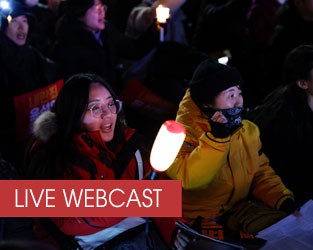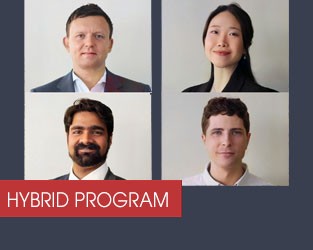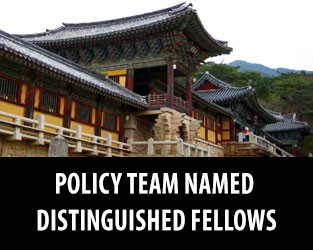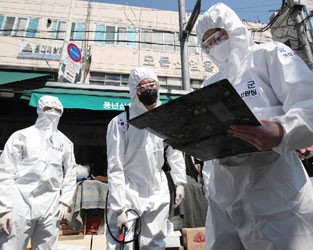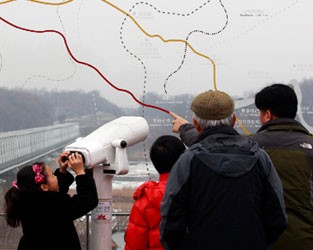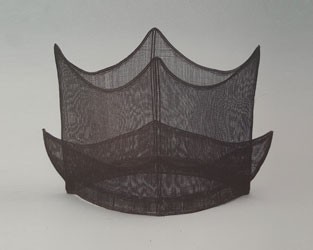Patently Great: Intellectual Property, Patent Growth, and Korea’s Global Lead
with
Mark Kresloff, Partner, McKenna, Long and Aldridge
Bumrae Cho, Associate, McKenna, Long and Aldridge
Hosted by Nikita Desai, Director of Policy and Corporate Programs, The Korea Society
NIKITA DESAI: (Moderator)
Welcome to The Korea Society, and welcome to Studio Korea. I'm Nikita Desai, director of policy and corporate programs.
Tonight we're pleased to have Mark Kresloff and Bumrae Cho of McKenna, Long & Aldridge join us for tonight's program, "Patently Great: Intellectual Property, Patent Growth and Korea's Global Lead." While in Denver last week, Ambassador Mark Minton (president of The Korea Society) and Ambassador Christopher Hill discussed this very issue in a conversation on Global Korea, which you can find on our website. Welcome, Mark and Bumrae.
I'd like to ask each one of you to spend a few minutes talking about your experience helping Korean clients with intellectual property issues, including your work with McKenna Long. Bumrae?
BUMRAE CHO:
Thank you for having me here this evening. My focus is on patent prosecution and litigation for the chemical and electrical industries. I also do some work with the mechanical device industry. I have worked for both Korean and US companies. I was born in Korea and worked there for seven years at a patent law firm. I moved to the United States at the age of thirty-four and now work for McKenna, Long & Aldridge.
MARK KRESLOFF:
Thank you, Niki. I've been practicing patent law for almost eighteen years now. Although my background is in biology and electrical engineering, my practice focuses on the telecommunications area—obviously important to Korean industry. I've been with McKenna, Long and Aldridge for almost ten years now and, like Bumrae, focus on helping clients with patent prosecutions. Prior to working with McKenna Long, I spent a year as a patent examiner at the United States Patent and Trademark Office.
I have worked with Korean clients since 2003 when I joined McKenna, Long and Aldridge. I've worked on many different technologies with our Korean clients—everything from washing machines and dryers to cell phones and telecommunications standards. I work a little with Bumrae helping him with chemical technology patents.
Patent prosecutors typically work with inventors and obtain patents for their clients as opposed to working with clients to litigate or license afterwards. Bumrae and I are both patent prosecutors who work on the front end of the patent process. We are pretty experienced and can give you some insight into our thoughts on Korean IP.
NIKITA DESAI:
You said you've lived in Korea?
MARK KRESLOFF:
I have. I lived in Seoul from 2008 to 2010 in order to get a little bit closer to our Korean clients. I also lived in Gangnam for a year. It was a tremendous experience for me. I loved living in Korea and learning all about their culture. It took me a while to learn how to get around Seoul, but after two years of living there, it became very easy to travel back and forth. I have really enjoyed my time in Korea.
NIKITA DESAI:
Bumrae, I understand you were first exposed to patent law while working at your father's boutique law firm in Korea. Tell us a little bit about your experience there.
BUMRAE CHO:
I started my career in the Korean military. After I completed my military service, I started working for a small IP law firm. My father was a partner at another law firm and I eventually moved there. I did a lot of patent prosecution work for both Korean firms. At the time I started working in law, Korean companies were globally expanding their patent portfolios. That gave me a really good opportunity to work on IP law for Korean companies.
NIKITA DESAI:
Mark, talk to us a little bit about patents. Why are patents becoming so important to Korea?
MARK KRESLOFF:
Let me start out by talking about patents in general. A patent is a right granted to an inventor or an assignee of an inventor by an entity like the United States or the Republic of Korea. When you invent something that is novel and meets all requirements, a patent is a negative right granted you for a certain period of time that prevents other people from making, using or selling your invention. Most people think it's a right to make or use your invention, but it's actually a negative right.
Patents are important because they help the patent owner protect his or her business, technology or market share. Patents can be used as a revenue source. If you license the patent, it can be used as a defensive shield if you're ever sued for infringing on somebody else's patents. Patents are an important business and revenue tool.
Korea has emerged as a global technology leader in the past two decades and as you'll see in some of the data I have, Korea started actively pursuing patent protection around the year 2000. Patents are important for Korea because of its global leadership role in technology. It's imperative that the companies, and the people who rely on those companies, protect their technology and market share worldwide.
NIKITA DESAI:
Let's go to that now. Tell us about the growth of the patent sector in Korea.
MARK KRESLOFF:
Aside from the fact that patents help the patent owner protect their market share, products and revenue sources, patents can be used as a metric or tool. They can be used by a company to make certain assessments about where the company is going with their own technology. Patents are a great indicator of this. Some of the data I'm going to show helps us see where Korea was, where they are now, and where they're going.
Most of this data comes from the World Intellectual Property Organization's website and actually pertains to statistics reflecting international applications. What you see here is a bar chart showing an upward trend from 1997 through 2011. The darker bars represent the number of patents filed by Korean residents, and you can see a general increase over the years. The number of patents increases rapidly in the late 1990s and early 2000s. It then starts to level off (I'm guessing due to the economy) but keeps increasing at a slower pace. I'd like Bumrae to speak more about that.
BUMRAE CHO:
I don't think many Korean companies were focused on patent applications before the year 2000, as they were more focused on exporting goods. Once these companies became successful, potential infringement issues started to appear. Korean companies may have paid royalties to US or global companies. I believe that after 2000, they started to file as many patents as possible. That is why you see the rapid increase from 2000 to 2005.
From 2005 to 2006, the Korean companies began to think more about the quality of the patents, because the number of patents filed does not reduce the royalties charged by other companies. Even though the number of patent applications has been stable for a few years, the number of foreign filings (the blue bar) has still been increasing.
MARK KRESLOFF:
The important takeaway here is that you can see a clear effort on the part of Korean companies (as well as the Korean government) to ensure that these companies are protecting their technology, and this rarely starts until the company is innovating.
As Bumrae mentioned, Korean companies started out as producers of goods which they sold in overseas markets. They started getting sued because there were American companies that had already been through the production cycle. These American companies were at the point of innovation and needed to protect their technology. The Korean companies realized they didn't have any protection. They had started bringing in a good revenue stream, and realized they needed to protect their markets.
As Bumrae said, at first there's a tendency to file a patent application on everything and anything; but numbers don't always tell the story. Usually when it comes to patents, quality means more than numbers. While you still see a significant number of patents being filed, Korean companies have come to realize that they need to concentrate on quality and not just quantity.
This slide shows exactly where Korean companies (and in some instances the Korean government) have focused their efforts. If you look at the upper-right quadrant, these four sectors reflect the patent applications filed by Korean companies or individuals. The technology where most of those filings are occurring is in the semiconductor area, audiovisual area (such as flat panel display devices, LCDs, LEDs, OLEDs) computer technology and, of course, telecommunications.
You see products from Korea all the time. When you go into Best Buy, you see TVs, phones and the like; so it is not really surprising that this is where you find the concentration of IPs. It's where the innovation and the protection are. These are clearly areas of technology that are the focus of Korean production. While Korea has focused on these particular technology disciplines, there are other technology disciplines that have not been the focus of Korea. Hopefully the industries they are working with eventually mature and you'll see other technology sectors follow the electronics disciplines.
Here is a list of Korean companies that are leading the way. You might think it's surprising that LG files more patent applications than Samsung. Again, I'll point out that these are international filings, not necessarily filings in Korea's patent office or necessarily national applications around the world. This chart still reflects something very important. If you look at each of these companies (who they are and what they do) you'll still see a focus on electronic, audiovisual and computer technologies. There are a couple of universities. You have KAIST down here. You have Seoul-dae here.
BUMRAE CHO:
And CJ. They're in the food and pharmaceutical industries.
MARK KRESLOFF:
They're like the lone exception. Everybody else is in the electronics space.
NIKITA DESAI:
Could you talk a little bit more about current IP trends in Korea?
BUMRAE CHO:
"Selection and concentration" is a well-known phrase in Korea. Many Korean companies select certain competitive areas and concentrate on developing their technologies in the selected areas. That means any field is very competitive between Korean companies, so every company invests a lot. Even though there is still room to grow in other areas, the trend in Korea (especially with large-size companies) is to focus on certain telecommunications or audiovisual [like LCD] areas. In addition, the recent Apple v. Samsung case taught Korean companies a lot. They are learning to defend themselves by preparing a good patent and also buying patents from US or international companies. This situation is changing all the time.
Then there is the issue of non-practicing entities (NPEs). The two biggest companies in Korea (LG and Samsung) are famous targets for patent infringement loss from NPEs. Some people call these patent trolls. Korean companies are now trying to prepare for situations like these. As they have been experiencing some litigation in United States courts, they are focusing more on developing and preparing certain areas of technology for potential risk with the patent infringement issue.
MARK KRESLOFF:
I would like to add to that. With regard to Korea's focus in these areas, I think there's a natural evolution going on. There was a time when the United States was making washing machines and cars and selling them around the world. We're not doing that much anymore and our share of the pie has certainly been reduced. But there comes a point in time where every country (even Korea) has the resources and the technological know-how, but they start getting replaced by other countries.
It takes some time to go from simply production to innovation, but that is a natural process. It was true in the United States and I think it will be true in Korea. Korea is at the point where they're not just making cars. I don't know how many of you remember the 1980s when the Hyundai first appeared in the United States. It was one of the least expensive cars you could buy, and the people who bought them were people who really couldn't afford other cars but wanted a new car.
Today, Hyundai is a quality car that ranks up there with any other cars available on the market today. Back in the 1980s, however, Hyundai probably wasn't concerned about protecting technology that wasn't unique, wasn't novel and wasn't innovative. Now, they're producing things that aren't just products—they're innovative products. The number of current patent filings reflects the state of technology in Korea. In terms of a trend, there now is further innovation in those areas where companies have already concentrated and there is more emphasis on technology areas where they haven't focused. I am hopeful that Korea will start developing into the technology areas they haven't yet attacked.
NIKITA DESAI:
Now that we've looked at the growth of patent development in Korea (and we certainly know it's a leader in technology development) how does that growth compare with its neighbors like China and Japan? How does it compare with Europe and the United States? Walk us through that a little bit.
MARK KRESLOFF:
First of all, Korea is now comparable to any economically-developed, post-industrial country in terms of dollars. When I get to my last slide, you'll see how far Korea has come. With the exception of Japan, when it comes to the absolute number of patents filed and technology protected, Korea really is second to none. I believe they rank fifth in the world in the total number of filings. If you focus on certain technology areas, they come in first or second. Japan still files a lot of applications. China is clearly nipping at everybody's heels. The United States is actually on a steady course. Again, you'll see from the numbers that Korea is leading in certain sectors.
This slide shows total filings from 1995 to 2011 for select areas internationally. Korea is represented by the purple line down here. You might be thinking that they're in fifth place, but you have to take into consideration several things: one being size and another being that Korea has tapped certain specific industries for protection. The United States is this blue line here. It's fair to say that the United States continues to file applications. There's a little dip here that may be related to the economy.
BUMRAE CHO:
I think it's economically related…
MARK KRESLOFF:
It probably is because of the economic crisis, which you see parallels Europe. Japan is the green line and it clearly indicates Japan's IP savvy. I want you to keep this in mind as we talk about this pie chart which shows a comparison of the share of international applications filed. If you take all of the international applications that were filed in 1995, you can see this tiny sliver representing 0.5 percent of the pie. That represents the number of applications filed by Korea in 1995. In 2011, Korea's share was 5.7 percent. You might not think that is very much, but that's truly an order-of-magnitude change.
When you look at the US's share of the pie, it looks as if they're not filing nearly as much. The truth is that countries like the United States are still filing more patent applications than ever; but other countries like Korea have become more patent savvy because they have products and innovation that need to be protected.
This data shows you a direct comparison between Korea and the other countries. I've highlighted China in red, Japan in purple, Korea in yellow, and the United States, over on your right, in blue. The numbers are listed by technology sector. You can see, just by virtue of these numbers (and this is over a five-year period) how many applications Korea is filing.
In the audiovisual technology space (technology that covers your computer displays, flat panels, smartphone displays and pad displays) you can see how many applications Korea has filed. Now they haven't filed as many as Japan, but they have filed more than the United States and far more than China. Korea has a significant number of filings in communications, including digital communications and semiconductors. As I said before, numbers aren't everything, but the numbers do indicate that Korea is filing these patent requests because there is technology and innovation to protect.
I mentioned before that there are technology areas that have not had Korea's focus. You can see some of these below, and they include mechanical engineering, machine tools, materials, and certain chemical and pharmaceutical areas. I don't interpret this data as Korea being weak in these areas. What it represents to me is the next generation of opportunity for Korea. Just as Korea has spent time focusing on the [technology sector, which they started in the 1970s and 1980s], now they're protecting [these products] because they're at the innovation phase. These untapped technology areas represent opportunities for Korea in the future. As they begin to manufacture and sell new products worldwide, you'll start to see patent filings in these areas, as well.
This slide shows who is who in the filing race. As you saw on an earlier slide, LG and Samsung file the most patents (this rating covers the top fifty companies). LG and Samsung were the only two Korean companies that made the top fifty as of 2011. As Bumrae pointed out, Korea has been focused on this particular technology sector. I believe that in the next ten to fifteen years this whole landscape will change, and you will see Korean companies in other disciplines making these lists.
I mentioned before to keep my first slide in mind as I remind you that Korea was at the bottom in terms of total number of filings from 1995 to 2011. Look where Korea is when you factor in GDP and standardize the data. When taking the country's economy and amount of production into account, Korea rates number one in filings per GDP with a fairly significant percentage over rival Japan, and based on a certain dollar level. I consider this a very significant statistic, particularly when compared to the total number of applications. This tells you something about Korea's products, technology, innovation and customers.
This is the last slide and a little off topic of how Korea compares with their competitor countries; but look at the orange bars. Even though it's not a steep slope, there is a relative increase. This bar represents the patent filings of non-Koreans and non-Korean companies in Korea. The increase is because these companies now see Korea as a market—not just a producing country. Because it's a market, people will be buying products from places like the United States or Europe. US and European companies realize this and feel the need to file for patent protection in Korea in addition to their own patent office. I also consider this significant.
NIKITA DESAI:
Thank you for walking us through that, Mark. The Korea-US Free Trade Agreement was implemented one year ago. Can you tell us a little bit about the effect of the FTA on the IT sector in Korea?
BUMRAE CHO:
Because of the FTA, Korean patent, trademark and copyright laws have been changed a little. A copyright is now protected for life plus seven years. It used to be life plus fifty years. In the trademark area, the Korean patent office will now accept scent marks and sound marks. Sixteen US and European law firms have opened branch offices in Seoul and even more law firms are expected to set up shop there to do business and compete.
The opening of the legal market in Korea requires a three-step process. The first step is to open a branch office in Seoul or somewhere in Korea. In two years Korea will allow foreign law firms (especially US law firms) to work for a client alongside Korean law firms for cases comprising both mixed domestic and international matters, and they can share the profits. In five years, Korea is required to open their market and allow US law firms and Korean law firms to create joint venture partnerships. The joint venture can hire either Korean lawyers or Korean patent attorneys and do business with Korean law firms. This is a huge change and will start in a few years.
MARK KRESLOFF:
The purpose of the FTA is to open markets. More US products will be available for sale and purchase in Korea and vice versa. This will most likely increase a company's interest in protecting their technology. Before the FTA, if a company didn't sell their products, they had no reason to protect those products. Once a company starts selling their products in Korea and innovation is involved, a company has more reason to protect those products—and the same goes for a Korean company selling products for the first time in the United States. I think the FTA will increase the awareness by companies that they have to protect their products and increase the number of patent filings.
NIKITA DESAI:
The Korean brand is noted for its product excellence. Samsung and LG are leading in terms of patent applications. Would you say that the number of patent applications points to more innovation? Would you say that Korea now has an innovation economy?
MARK KRESLOFF:
Well, as I mentioned earlier, numbers don't tell the entire story. As Bumrae mentioned when we looked at this chart for the first time, Korean companies realized that numbers don't necessarily equate to profits or protection against lawsuits. The key is to make sure you are being innovative and your focus is on protecting that innovation.
To answer your question more directly, I believe Korea to be an innovation economy. When it comes to telecommunications, for example, there are standards that govern almost every piece of technology produced. Every chip in your smartphone operates on algorithms, procedures and methods, and they all need to be standardized. If they weren't, then your smartphone in the AT&T network could not communicate with a smartphone in the Verizon network. If I had an iPhone and wanted to talk to Bumrae on his Samsung Galaxy, I wouldn't be able to communicate with him without these standards.
The telecommunications industry has organizations that come up with these standards, and these organizations include members of that industry. A 3GPP standardization organization that creates standards for our smartphone and telecommunications technologies has members that include Samsung, LG, Motorola, Ericsson, and Qualcomm. In addition, telecommunications technology has matured so much over the last few years that when a company files a patent application, it's usually for an incredibly small change over existing technology.
Even though that change may be very minor, in many cases you can still get a patent on it and it becomes a requirement of the standards. Why is that important? If it is a requirement of the standards, that means everybody in the industry is practicing your technology. And everybody practicing a technology has to have a license or they can't practice it. If they can't practice it, they can't sell their smartphone.
For example, we file hundreds (probably close to a thousand) patents every year for my client LG. Many of them are telecommunications-based, and many seem like very small leaps in innovation. Almost every single one of them that are standard blocking makes them money in licensing fees and from the standardization organizations—and those are very important. Yes, it's innovation and it's valuable. I definitely see Korea as an innovative country. There are many levels to innovation, and I'm hoping to see this happen in other technology sectors as well as telecommunications.
NIKITA DESAI:
That brings me to my last question. We talked about a few sectors in which Korea can move forward. What are some of the future trends that you see? Where can Korea go from here?
BUMRAE CHO:
Korea will keep up with any international trends. In certain areas such as telecommunications, Korea is most likely to keep pace with US leading companies. Any technological areas that are less concentrated are likely to emerge.
MARK KRESLOFF:
And why is that significant? We saw Korea's increase in focus and innovation in the technology industry by looking at the patent metric. What's going to happen, particularly in electronics, is there will come a point where Korea will have a difficult time manufacturing some of these devices at a cost that is competitive. This is a natural evolution. Sooner or later, they're going to make things cheaper in Vietnam, the Philippines, and clearly in China.
What do you do if you're Korea? The same thing that the United States has done in order to maintain its competitiveness—although they're no longer making as many things as they used to make and selling them abroad. Korea will move into these new areas and develop these new areas while other countries slowly move up and take Korea's place in the areas they used to dominate.
You see this happening now with China. Another country that is filing a lot of applications for patents (that you might not even think about) is India. If you look at the data, in ten years countries like India will be making a lot of these products. They will start making money just like Korea did, they will start innovating like Korea did, and they will start filing applications to protect their technology. Korea, being the industrial highly-developed country, will move into other areas of technology because they have to. That is the natural evolution of things, and that's what you're going to see.
[End]
" target="_blank">iTunes
![]()


